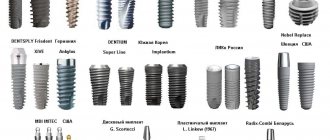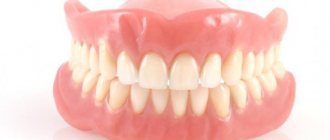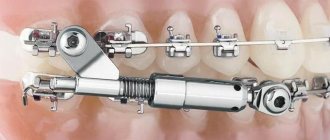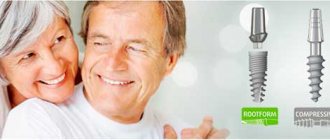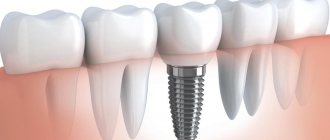From this article you will learn:
- What is an implant
- Pros and cons of implants
- Types of implants
- Installation methods
- Rehabilitation and rejection after the procedure
- Implant failure - what to do in this case
- Contraindications
- Questions and answers?
Losing a tooth relieves pain and inflammation, but gives rise to other problems. The chewing process is disrupted, and displacement of molars and premolars may begin. Therefore, it is necessary to restore the integrity of the dentition. Installing dentures and bridges is inconvenient and not always possible. Implants combine convenience, reliability, safety and guarantee a beautiful smile.
What is an implant
A dental implant (implant) is an artificial multi-component structure that is installed into bone tissue. After fusion, crowns are fixed to it. In simple terms, an implant is an artificial root that performs all the functions of a lost tooth.
A dental prosthesis is implanted into bone tissue. Then an abutment (periosteal element) and a crown are mounted on it.
Dental implant
Indications for installation are partial or complete edentia, restoration of lost incisors, molars, premolars and canines.
Pros and cons of implants
Installation of pins in bone tissue requires the experience and practical knowledge of a maxillofacial surgeon and implantologist. And fulfillment of all his prescriptions by the patient. In addition, before implantation, the oral cavity is sanitized and any inflammatory processes are stopped.
| pros | Minuses |
|
|
Table. Advantages and disadvantages of implants
Distinctive features of DENTIUM implants:
- The root-like anatomical shape of the titanium implant allows for a faster response from the bone tissue and accelerates healing. In addition, due to the larger surface area of the implant, the stability of the prosthesis soon after installation is significantly improved.
- The double threads with increased pitch and high ribs will also speed up healing by allowing new connective tissue to fill the gaps between the threads more quickly and also facilitate quicker implant placement.
- The surface treated with aluminum oxide particles and a mixture of acids, which combines macro- and micro-roughness as a result - the so-called SLA surface - is one of the best implant surfaces currently in terms of the rate of formation of bone tissue on it and the possibility of early loads.
- A wide selection of components of various sizes, which allows you to select a suitable prosthesis in all or almost all cases. The internal connection is the same for all types of DENTIUM implants, which also increases variability when choosing a model, and the duration of use of the established technology allows us to keep turnkey prices per tooth lower than other systems.
Types of implants
Currently, many types of dental structures have been developed that will help solve any patient’s problem. The choice of implant is the prerogative of the doctor. And it depends on the diagnosis and individual characteristics of the patient.
By purpose
There are 2 groups of dental structures – intraosseous and extraosseous. The first ones are made of titanium alloys. They reproduce the shape of the tooth and are made with or without threads. Their surface is specially treated to increase the speed of osteosynthesis. Screw implants are the most common.
Screw implants
Extraosseous structures are indicated when it is impossible to use intraosseous titanium pins.
Types of dental implants:
- subperiosteal - indicated for insufficient bone tissue. Allows you to avoid sinus lift surgery. Installed in the periosteum, between the bone structures and the gum;
Subperiosteal implants
- stabilizing – help preserve the tooth root, making it longer. They are classified as temporary structures and are currently practically not used;
Stabilization implants
- intramucosal - installed in the mucous membranes, bone tissue is not affected. Used to attach removable dentures.
Intramucosal implants
According to the type of fixation in the bone
Based on the method of fixation in tissues, root, basal and zygomatic dental structures are distinguished.
Root - the most popular, are a threaded cylinder. Can be installed if there is a lack of bone tissue.
Basal - began to be used relatively recently. They are installed in deeper bone structures (basal bone). Their installation does not require sinus lift surgery; they are suitable for one-stage implantation and better distribute the load during chewing.
Zygomatic pins – used in cases where other methods and types of dental implants are contraindicated. They are mounted in the zygomatic bone, which makes it possible to restore the upper dentition in case of complete atrophy of bone tissue.
By design
There are one-piece, two-piece and mini-implants. The former are used for express methods of restoring a lost molar, incisor or canine. In them, the abutment is already fixed to the intraosseous part of the device. When installed above the gum, the top of the one-piece implant remains. You can immediately install a crown on it.
Two-piece ones consist of a titanium pin itself, which is immersed in the bone. Several months should pass after its installation. This implant has a recess onto which the abutment is attached. This allows, if necessary, to replace the upper part of the structure without removing the pin. This is the most popular type of implant.
One-piece and two-piece implants
The smallest dental structures are mini-implants. Their sizes range from 1.8 to 2.4 mm. The installation is painless and takes root within a month. The crown or prosthesis is installed 3 days after implantation. They are used, as a rule, for attaching removable dentures.
Mini implants
By class and manufacturer
Today, there are 3 classes of titanium pins on the dental construction market - economy, medium and premium segment.
Premium class implants are distinguished by higher quality materials and have greater capabilities. They are recommended for use in difficult cases. They are easier for the dentist to work with. In addition, the manufacturer offers many additional elements, crowns, and abutments.
Well-known manufacturers of titanium structures in dentistry:
- Straumann and Nobel Biocare (Switzerland);
Straumann implants
- Denstply – products under the TM Ankylos, Xive Friadent (Germany), Astra Tech (Switzerland);
- MIS, AlphaBio, Ards (Israel);
MIS implants
- MegaGen
MegaGen implants
Economy and mid-range segments are no worse in quality. And you need to understand that when implanting, the main thing is the knowledge and skills of the dentist.
Morse taper and conical platform.
In the article “Don't Get Trapped on a Cone,” I said that according to most marketers, any conical platform is a Morse cone. But that's not true.
If you are too lazy to follow the link, I will very briefly tell you what this geometric figure is and why all orthopedists like it so much.
So, a cone is a figure of rotation. It is formed by rotating a right triangle around the larger of its legs, which is its axis. To be more precise, we are dealing with a straight circular cone (its base is a circle).
From a geometry point of view, it has several characteristics that interest us.
The slope of a cone is measured in degrees between its axial perpendicular and any lateral surface. Sometimes the slope is confused with the angle of the cone , or simply the angle of the cone formed between the surfaces at its apex. For a straight circular cone, the opening angle is two slopes.
In the literature and descriptions of prosthetic interfaces, one can find both the slope characteristic and the opening angle of a conical orthopedic platform. It is important not to confuse them.
For example, for the Astra Tech implantation system (Dentsply Sirona Implants), the slope of the conical platform is eleven, and its opening is 22 degrees.
Another important characteristic of a cone as a geometric figure is its taper , the ratio of height to diameter. The taper is equal to the tangent of the slope and is usually written as a ratio. So, for the same conical Astra Tech platform, the taper will be tg(22)=0.40 or 1:2.5.
Most conical platforms have similar parameters - the opening angle ranges from 22 to 26 degrees, and the taper ranges from 1:2.5 to 1:2. Obviously, these figures appeared for a reason and were calculated by engineers, scientists and doctors. There are not many exceptions to this range. In particular, the opening angle of the Ankylos implant platform is 11 degrees, and its taper is 1:5.
In 1864, Stephen Morse proposed his own version of the conical mount, which was later named after him. The parameters of the Morse taper, widely used in industry, are as follows: taper from 1:19 to 1:20, which corresponds to an opening angle of 2.8 to 3 degrees and a cone slope of 1.4 to 1.5 degrees. This type of connection literally centers and “jams” a rotating tool, which is widely used in various tools, lathes, all sorts of spindles, etc.:
But in implantation systems, the Morse cone is rarely found. Personally, I know of only one implantation system with a platform whose parameters correspond to the Morse cone. And this is Bicon:
Surely, there are other systems with similar characteristics, and I will be glad if you tell me about them. Interesting to see.
Why are conical platforms so popular among orthopedists? And why is a REAL Morse taper such a rarity in the design of implantation systems?
The reason is exactly. Imagine a situation where you need to fix a prosthesis on several implants at once. In order for the “mounts” to match exactly, the distance between the axes of the implants and abutments must match perfectly, and any, even the most minimal error will not allow you to screw the prosthesis to the implants.
In a conical platform, the abutments are self-centering - and this will allow you to easily fix a prosthesis made even with significant tolerances:
Conversely, fixing such a prosthesis on implants with a flat platform or a platform “a la Morse taper” will be difficult - a loss of accuracy of several micrometers will not allow you to correctly install the abutments.
Therefore, multi-purpose abutments, MP or MultiUnit, are often used for large dentures - in addition to convenient supragingival impression taking, they slightly compensate for inaccuracies, which makes it easier to fix large dentures.
Life time
Manufacturers provide an almost lifetime warranty on dental structures. For example, Alpha Bio is 30 years old, but if a pin fails within 5 years after installation, it will be replaced free of charge. And Astra Tech, MIS, Nobel, Straumann, Osstem and Biohorizons, Ankylos will replace them regardless of the service life of the device.
Crowns that are installed on an artificial root are designed to last 10–15 years.
Factors affecting the service life of the device:
- professionalism of doctors who are involved in the implantation process;
- quality of titanium pins;
- condition of teeth, bone structures, general medical history of the patient;
- quality of oral care after installation of a dental structure.
Important! A mandatory condition for providing a guarantee is an annual dental examination.
Installation methods
The classic method of implantation is surgery, followed by a long period of osteosynthesis. Modern techniques make this process easier and faster.
Types of dental implantation:
- Traditional – carried out in 2 stages. The crown is installed six months after implantation.
- One-stage – the crown is installed immediately after implantation.
- Basal – pins are installed in the basal bone; sinus lift surgery is not required.
- Translingual - the artificial root is inserted through small punctures. The technique is considered minimally invasive. The crown is fixed after 3–4 days.
The method of installing dental structures is chosen by the doctor. It depends on the patient’s diagnosis and associated factors.
Rehabilitation and rejection after the procedure
Installation of a titanium pin does not require hospitalization and is performed under local anesthesia. After the procedure, the patient goes home. Survival rate and the absence of complications depend on the quality of oral care and compliance with the dentist’s prescriptions.
Recommendations for nutrition for 3 days after surgery:
- do not eat for 3 hours after the procedure;
- the first day - soft, warm, non-acidic and non-spicy food;
- chewing load - only on the healthy side;
- Alcohol and smoking are prohibited;
- It is advisable to exclude coffee and tea; the best option is herbal tea, unsweetened compote;
- observe the drinking regime.
Attention! Alcohol after implantation is completely and categorically prohibited. It promotes the destruction of bone tissue and slows down the healing process. In addition, the doctor will prescribe antibiotics. Alcohol intake is dangerous for the patient's life.
Hygiene rules:
- there is no place for hands in the mouth;
- 3–4 days – only oral baths with prescribed medications, rinsing is strictly prohibited;
- 3–5 days after examination by a doctor, you are allowed to use a toothbrush;
- 2 weeks after implantation, start using an irrigator.
After surgery, buy a new toothbrush. This way you will reduce the risk of wound infection by pathogenic flora.
After implantation it is strictly prohibited:
- using electric toothbrushes;
- brushing teeth with floss;
- carry out hygienic cleaning without a doctor’s referral - the dentist must know and be able to work with implants. Therefore, only as prescribed by the implantologist;
- chew nuts, pencils, bite any hard objects.
Smokers should give up cigarettes at least until the stitches are removed. Then after each smoking session you need to do a mouth bath with chlorhexidine.
Details about dental implantation, its advantages and contraindications
Dear guests of our site! In one of the previous sections, we said that dental implantation is sometimes called the “third change of teeth.” And this is close to the truth! The fact is that it is the basis of the most modern method of dental prosthetics, which in turn is the only way to restore the integrity of the dentition without damaging the remaining teeth, giving a full feeling of your own teeth.
Therefore, below we will try to tell you in detail and clearly about dental implantation, its advantages over traditional dental prosthetics, contraindications to its use and the dental implants themselves (natural photographs of surgical operations are excluded or, if possible, replaced with drawings).
According to expert estimates, in our country there are about 10 million edentulous, that is, completely edentulous (lack of teeth), citizens. And yet no one undertakes to estimate the number of people who have lost at least one tooth. It is clear that this is tens of millions.
In the ordinary mind, the loss of a tooth is nothing or a cosmetic problem, but in the strictly scientific mind, such a person becomes disabled. The fact is that human teeth are a bone formation in the oral cavity for grasping, holding and mechanically processing food. In humans, teeth are also involved in the pronunciation of sounds. For the normal performance of all the above functions, a person must have 32 teeth, and the loss of even one tooth affects not only speech, facial structure, smile, timbre of voice, but also the ability to chew, that is, the quality of food, which means human health . In this case, disturbances in the functioning of internal organs and, first of all, diseases of the gastrointestinal tract are possible. And this is already serious!
Dental implants not only allow a purely mechanical replacement of missing teeth, they create a new sense of self, and therefore a new image of a person. And what in this regard could be more important for a person who no longer feels disabled!
Dental implantation is based on the phenomenon of osseointegration, which allows titanium to completely fuse with bone tissue, accidentally discovered in 1953 by a Swedish scientist, Professor Per-Ingvar Brånemark, who laid the foundation for modern aesthetic dentistry based on dental implantation and gave millions of people the opportunity to have a full smile .
The operation of implanting a dental implant (an artificial root of a missing tooth) is not a time-consuming (15-20 minutes), virtually painless procedure, performed under local anesthesia. The patient indirectly feels only the professional manipulations of the hands of a dental surgeon - implantologist.
The dental implant itself is a rod 3-5 mm in diameter, the material for which is titanium group metals. Titanium has been and remains “number one” for the production of dental implants. Recently, titanium alloys have been actively used to increase the bioinertness of titanium while simultaneously increasing its strength.
After the process of osseointegration (fusion) after the dental implantation (implantation) operation is achieved, the so-called “primary stability of the implant” in the jaw bone is achieved, which allows, with minimal risk, to begin the procedure for installing an abutment (a connecting adapter between the implanted implant and the prosthetic structure attached to it), the direct process of prosthetics begins, i.e. production of an individual metal-ceramic (metal-free, zirconium) crown and installation of it on an implanted implant.
An implant implanted into the bone serves as a support either for an artificial tooth or for reliable fixation of a removable denture in the oral cavity.
For the latter purpose, mini-implants are often used - almost the same implants, only with a simplified design and smaller size (1.8-2.0 mm in diameter), which makes them more acceptable, especially for older patients, because allow our dentists to help those patients who, for one reason or another, cannot endure the complexities of a conventional implantation operation or do not have sufficient bone or financial resources to install standard size implants.
A mini-implant is a titanium screw with a ball-shaped head, which is surgically screwed into the jaw, and the head protrudes into the oral cavity and provides a reliable support for a removable denture. A special mount is mounted into the base of your removable denture, consisting of a stainless steel matrix body and the plastic matrix itself, which acts as a socket for the round head of the mini-implant. In this case, the prosthesis itself lies softly on the gum. For reliable fixation of a removable denture, the installation of 2-4 mini-implants in the jaw is sufficient.
The use of mini-implants for fixing removable dentures can significantly enhance their fixation and raise the patient’s psychological self-esteem. With mini-implants you can really enjoy food, pleasant conversation, laugh and talk with confidence! And all this for a very reasonable fee!
At the Ryazan Center for Dental Implantation, the cost of installing one mini-implant, including one made of nanotitanium, including the price of the implant itself and the matrix attached to it, is only 8,500 rubles!
It is important to note that dental implantation should begin with a mandatory in-depth X-ray examination of the jaws using a three-dimensional digital computed tomograph (and, if necessary, with a study of the patient’s general health) and subsequent sanitation of the oral cavity. A big mistake for a patient planning to undergo dental implantation is to carry out the specified sanitation, and especially the procedure for preliminary removal of the tooth(s) in any third-party clinic. The fact is that, firstly, any tooth extraction in general can be carried out only after an initial consultation with an orthopedic dentist and an implant surgeon; secondly, the latter, like no one else, will carry out the necessary removal with the least trauma to the jaw bone (he Let’s continue to work with this place!), thirdly, in some cases, if the dentist has a sufficient level of professionalism, it is possible to directly combine the procedure of tooth extraction with subsequent implantation. Why have two postoperative periods if you can limit yourself to one, and at the same time save at least a month of time required for wound healing after tooth extraction!
In addition to the essence of dental implantation stated above, it should be borne in mind that, firstly, within the framework of one dental implantation operation, it is possible to implant several implants into a patient at once (in the practice of our clinic - up to nine units), and, secondly, restoration dentition on a completely toothless jaw.
Secondly, the specialists of our center began to carry out so-called “minimally invasive” surgical operations for dental implantation, i.e. without cutting the gums, when the implant is implanted into the bone tissue directly through the mucous membrane. This is achieved through the combined use of a powerful dental CT scanner and a special 3D printer, resulting in a customized surgical jaw template with guides for more precise placement of the implant in the jaw.
This method, with its obvious advantage, is also important for performing dental implantation for people with high blood pressure and other diseases, because less traumatic and has an easier postoperative period.
And finally, if necessary, when the patient has a loss (loss) of jaw bone tissue, for example, as a result of many years of missing teeth or trauma, our clinic successfully performs complex osteoplasty operations - correction of bone defects. According to the admission of dental surgeons themselves, osteoplastic surgery, due to the high level of complications and sometimes the need for repeated surgery, is the most difficult section not only of implantology, but also of surgical dentistry.
Having the necessary knowledge and professional skills in dental implantation, using the latest X-ray diagnostic equipment in this field, equipped with three-dimensional visualization systems for very precise (up to 0.1 mm) planning of optimal implant placement sites and surgical procedures, up to the creation of a 3D computer model of the future orthopedic designs, our specialists have the opportunity, even before the start of treatment, to assess the volume of intervention, the number and type of implants installed and their adequacy in relation to the future orthopedic design. All this significantly increases the success rate and predictability of the treatment process.
For clarity, below let us give one of the many examples of the work of our clinic’s specialists:
Recommendations for patients to follow before and after dental implantation surgery:
— It is advisable to come to the operation in light, non-restrictive clothing with short sleeves (ideally a T-shirt). Women's facial skin should be free of all cosmetics;
— the day before and on the day of surgery, do not drink alcohol, coffee, or strong tea, because these drinks increase blood pressure and can lead to increased bleeding;
- blood pressure on the day of surgery should be normal. To stabilize it, if necessary, use your usual measures;
- 1 day before surgery, you should stop taking blood thinning drugs, anticoagulants and antiplatelet agents that cause the risk of bleeding during surgery;
- all chronic diseases, if any, must be in remission;
— the patient should not simultaneously undergo intensive therapy for other diseases;
- on the eve of the operation, to prevent infection, carry out professional oral hygiene and remove plaque, tartar and subgingival dental plaque;
- after surgery, it is contraindicated to engage in any physical labor;
- you need to sleep on the other side of your face or on your back;
- avoid physical activity, hypothermia and overheating for 10 days after surgery;
- avoid eating rough, spicy and hot foods;
— brush all teeth, but with the exception of the implantation area, under no circumstances run a toothbrush along the seams to avoid suture separation and wound infection;
- Be sure to take medications prescribed by your doctor.
- make sure that in the first days after surgery you do not get colds or infectious diseases. This is fraught with an unsuccessful outcome of implantation. Therefore, it is advisable to refrain from visiting the company of sick people or public institutions during seasonal colds.
- you cannot smoke (at least for several hours after the end of the operation);
- maintain cleanliness in the oral cavity, prevent the formation of plaque on the teeth and in the implantation area.
Please remember! Dental implantation is a small, uncomplicated, but still full-fledged operation. It is necessary to take all recommendations seriously!
Advantages of dental implantation over traditional dentures:
— Your new teeth are securely held in the jaw;
— crowns on implants do not differ from your natural teeth;
— there is no need to grind adjacent teeth;
— the possibility of installing dentures in the absence of teeth;
— You can eat any food without it getting stuck under crowns and dentures;
— implants provide the necessary load on the jaw bone when chewing, which means you are reliably protected from the problem of jaw bone destruction, the appearance of wrinkles around the mouth, sunken cheeks and changes in facial contour;
— artificial teeth based on implants are reliable and safe, do not distort the taste of food and do not require any correction for a very, very long period of time;
— dental implants are made only from environmentally friendly and bioinert materials.
Indications for dental implantation
:
- absence of one or more teeth;
— limited included defects of the dentition;
- terminal unilateral and bilateral defects of the dentition;
- complete absence of teeth, especially with a decrease in the height of the alveolar processes.
Contraindications to dental implantation:
a) general (absolute) contraindications
:
- any grounds for refusing surgical intervention as such;
— any contraindications to local anesthesia;
- diseases that can be negatively affected by implantation (for example, endocarditis, artificial heart valve or pacemaker, organ transplantation, chronic diseases: tuberculosis, diabetes mellitus in extreme form, stomatitis, diseases of the oral mucosa, etc.);
- forms of therapy that may adversely affect the healing and preservation of the implant, as well as its bed (for example, immunosuppressive drugs, antidepressants, anticoagulants, cytostatics);
- diseases of the blood and hematopoietic organs;
- diseases of the skeletal system that reduce its regenerative capabilities, osteoporosis;
— diseases of the central and peripheral nervous system;
- malignant tumors during the period of special therapy and some time after its completion.
b) relative contraindications
:
— periodontitis (acute and subacute forms);
- pathological bite and increased tooth wear;
- poor oral hygiene and lack of habit of maintaining it;
- precancerous and tumor-like diseases in the oral cavity and jaws;
— diseases of the temporomandibular joint;
- bruxism (grinding of teeth in sleep);
— anatomical features of the structure of the jaws, excluding the possibility of introducing implants without previous bone reconstructive operations.
c) temporary (local) contraindications
:
— stages of rehabilitation and recovery;
— pregnancy and lactation;
- drug addiction;
— period after irradiation (at least one year);
- a period associated with severe psychological and physical stress;
- acute diseases;
- insufficient propensity for oral hygiene.
The patient's age is NOT a contraindication to dental implantation surgery.
!
Smile and be healthy!
Implant failure - what to do in this case
Rejection is an inflammatory process that is accompanied by the destruction of bone tissue. Causes pain, swelling of the gums, bleeding, and purulent exudate.
Types of rejection:
- early – begins immediately after surgery – the main reason is a violation of implantation protocols;
- medium-term – 1.5–2 years after installation of the pins. The reasons are various – from hormonal imbalance to increased chewing load on the implant;
- later – after 2.5–3 years – the main reason is violation of hygiene rules.
Rejection is an extremely rare complication after the installation of a dental structure. If any alarming symptoms appear, you should contact a medical facility.
Possible complications after implantation
After any stage of treatment, typical complications may occur:
- Infection
- Bleeding
- Swelling of the gums and face
- Nerve injury
- Pain in the installation area
- Implant mobility
- Implant exposure
- Product breakdown, etc.
If swelling, redness and pain do not subside, worsen within a few days after surgery, or are accompanied by new symptoms, contact your surgeon. You may need antibiotics, pain relievers, or other help.
Immediately after each stage (surgery), the doctor will recommend not to injure the gums and refrain from spicy, salty or hard foods. Typically, absorbable suture material is used in dentistry; otherwise, after suturing the wound, an unpleasant manipulation will be required - removal of the sutures.
Contraindications
All contraindications are divided into absolute and relative. It is strictly prohibited to install titanium pins in the following cases:
- blood diseases – the risk of bleeding and implant rejection increases;
- active cancer, during chemotherapy and radiotherapy – the risk of metastasis increases;
- diabetes mellitus in the stage of decompensation;
- taking cytostatics, any immunodeficiency states;
- intolerance to local and general anesthetics.
Previously, the list of contraindications to dental implantation was wider. But modern technologies and improved surgical techniques have expanded the capabilities of both patients and doctors.
Relative contraindications:
- pregnancy and lactation - any operation causes stress. Therefore, it is better to postpone the procedure until the end of breastfeeding;
- malocclusion - first correction, then installation of pins;
- inflammatory processes in the mouth, nasopharynx;
- exacerbation of any chronic disease.
In addition, it is forbidden to install implants before the age of 18, since the bone tissue is still forming. Old age is not a contraindication for dental implantation.
Preparation for dental implantation
Since the treatment involves several procedures, the doctor must carefully examine you, make sure there are no contraindications and prepare a clear plan.
X-rays and computed tomography (CT) allow us to assess the condition of teeth, bones and surrounding tissues, so no specialist will begin responsible treatment without pictures. In this case, CT is superior to conventional x-rays, as it allows one to obtain detailed layer-by-layer images.
Based on the results of the examination, a treatment plan is drawn up, which takes into account numerous individual factors: the number of teeth for implantation, location, condition of the jaw bone, sinuses, etc.
When planning, you may need to consult several specialized specialists (for example, an otolaryngologist or an oral and maxillofacial surgeon).
Be sure to tell your doctors about your chronic diseases (such as cancer or diabetes), medications, and dietary supplements you are taking. If you have serious heart disease or have orthopedic implants (such as an artificial hip), this may affect your future treatment.
For effective pain relief during surgery, local anesthetic, sedation, and general anesthesia (anesthesia) are used. After surgery, antibiotics are prescribed to prevent infections. It is important to know if you have any allergies to medications.
Questions and answers
Is it painful to have implants installed?
Implantation is a full-fledged operation. It is performed under local anesthesia or general sedation. The choice of drug and method of administration is the prerogative of the doctor. After the operation, the dentist will prescribe adequate pain relief.
Is there a difference in installation between the upper and lower jaw?
Yes, the roots of the teeth of the upper jaw abut or enter the upper maxillary sinus. Before implantation, an operation is required to lift the bottom of the sinus and build up bone tissue. In addition, in some cases, zygomatic implants are used. Bone augmentation to install a pin in the lower jaw may not be performed. This depends on the results of the patient's examination.
At what age are implants placed?
From 18 years and older. Old age is not a reason for refusing to install a dental structure. The procedure is allowed at both 70 and 80 years of age.
Is it possible to do an MRI after implantation?
Dental implantation is not a contraindication for either MRI or CT. The dental structure is made of titanium alloy. During the procedure, it will not heat up, will not move, and will not cause pain.
Benefits of the procedure
You can restore lost teeth with a guarantee of long-term results. Implants will last for 25 years or more without any problems. There is no need to grind down teeth that act as supports when installing bridges.
This is a priority method compared to removable dentures, since it allows you to achieve a natural and natural smile without the sensation of a foreign body in the oral cavity.
Operation
Medium difficulty
There are contraindications
Doctor's qualifications
High
Free dental consultation
Our clinic offers a free examination by a dentist or implantologist. The doctor will examine the oral cavity and give recommendations for treatment and dental prosthetics.
You can read all the nuances of implantation in the article.
To find out more about prices for treatment and installation of implants, go to the appropriate section of our website. Registration for a consultation is carried out by phone and 7(920)-090-49-94, in the feedback form and during a personal visit to the clinic.
You can also find more information about installing implants in the article.
Results of dental implantation
Today, the vast majority of procedures are successful, but in some cases the implant may not fuse well with the bone. Smoking, for example, contributes to implant loosening and other serious complications.
If the implant becomes loose, the implant is removed, the bone is thoroughly cleaned, and you can try the treatment again after 2-3 months of recovery.
To prevent complications, doctors recommend:
- Oral hygiene
: Just like natural teeth, crowns need to be kept clean. Specially designed brushes for thorough cleaning of the interdental space will help avoid the accumulation of bacteria and inflammation.
- Regular visits to the dentist
: To prevent infections, preserve implants and receive timely care, visit your doctor every six months.
- Avoiding bad habits
: in addition to smoking, which contributes to loosening of the implant, you should not chew very hard food (caramel) or use new teeth for other purposes. Let's say, for opening bottles.
Take care of your health and return to the surgeon as rarely as possible!

